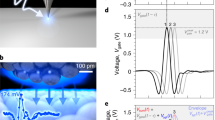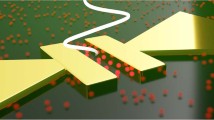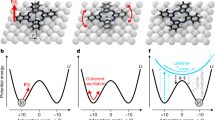Abstract
Bringing optical microscopy to the shortest possible length and time scales has been a long-sought goal, connecting nanoscopic elementary dynamics with the macroscopic functionalities of condensed matter. Super-resolution microscopy has circumvented the far-field diffraction limit by harnessing optical nonlinearities1. By exploiting linear interaction with tip-confined evanescent light fields2, near-field microscopy3,4 has reached even higher resolution, prompting a vibrant research field by exploring the nanocosm in motion5,6,7,8,9,10,11,12,13,14,15,16,17,18,19. Yet the finite radius of the nanometre-sized tip apex has prevented access to atomic resolution20. Here we leverage extreme atomic nonlinearities within tip-confined evanescent fields to push all-optical microscopy to picometric spatial and femtosecond temporal resolution. On these scales, we discover an unprecedented and efficient non-classical near-field response, in phase with the vector potential of light and strictly confined to atomic dimensions. This ultrafast signal is characterized by an optical phase delay of approximately π/2 and facilitates direct monitoring of tunnelling dynamics. We showcase the power of our optical concept by imaging nanometre-sized defects hidden to atomic force microscopy and by subcycle sampling of current transients on a semiconducting van der Waals material. Our results facilitate access to quantum light–matter interaction and electronic dynamics at ultimately short spatio-temporal scales in both conductive and insulating quantum materials.
This is a preview of subscription content, access via your institution
Access options
Access Nature and 54 other Nature Portfolio journals
Get Nature+, our best-value online-access subscription
$29.99 / 30 days
cancel any time
Subscribe to this journal
Receive 51 print issues and online access
$199.00 per year
only $3.90 per issue
Buy this article
- Purchase on Springer Link
- Instant access to full article PDF
Prices may be subject to local taxes which are calculated during checkout





Similar content being viewed by others
Data availability
Source data are provided with this paper. All further data are available from the corresponding authors.
References
Hell, S. W. Far-field optical nanoscopy. Science 316, 1153–1158 (2007).
Betzig, E. & Trautman, J. K. Near-field optics: microscopy, spectroscopy, and surface modification beyond the diffraction limit. Science 257, 189–195 (1992).
Zenhausern, F., Martin, Y. & Wickramasinghe, H. K. Scanning interferometric apertureless microscopy: optical imaging at 10 angstrom resolution. Science 269, 1083–1085 (1995).
Knoll, B. & Keilmann, F. Near-field probing of vibrational absorption for chemical microscopy. Nature 399, 134–137 (1999).
Qazilbash, M. M. et al. Mott transition in VO2 revealed by infrared spectroscopy and nano-imaging. Science 318, 1750–1753 (2007).
Fei, Z. et al. Gate-tuning of graphene plasmons revealed by infrared nano-imaging. Nature 487, 82–85 (2012).
Chen, J. et al. Optical nano-imaging of gate-tunable graphene plasmons. Nature 487, 77–81 (2012).
Lundeberg, M. B. et al. Tuning quantum nonlocal effects in graphene plasmonics. Science 357, 187–191 (2017).
Huber, M. A. et al. Femtosecond photo-switching of interface polaritons in black phosphorus heterostructures. Nat. Nanotechnol. 12, 207–211 (2017).
Sunku, S. S. et al. Photonic crystals for nano-light in moiré graphene superlattices. Science 362, 1153–1156 (2018).
Jiang, T., Kravtsov, V., Tokman, M., Belyanin, A. & Raschke, M. B. Ultrafast coherent nonlinear nanooptics and nanoimaging of graphene. Nat. Nanotechnol. 14, 838–843 (2019).
Esmann, M. et al. Vectorial near-field coupling. Nat. Nanotechnol. 14, 698–704 (2019).
Hu, G. et al. Topological polaritons and photonic magic angles in twisted α-MoO3 bilayers. Nature 582, 209–213 (2020).
Zhao, W. et al. Efficient Fizeau drag from Dirac electrons in monolayer graphene. Nature 594, 517–521 (2021).
Dong, Y. et al. Fizeau drag in graphene plasmonics. Nature 594, 513–516 (2021).
Zhang, Q. et al. Interface nano-optics with van der Waals polaritons. Nature 597, 187–195 (2021).
Sternbach, A. J. et al. Programmable hyperbolic polaritons in van der Waals semiconductors. Science 371, 617–620 (2021).
Plankl, M. et al. Subcycle contact-free nanoscopy of ultrafast interlayer transport in atomically thin heterostructures. Nat. Photon. 15, 594–600 (2021).
Meirzadeh, E. et al. A few-layer covalent network of fullerenes. Nature 613, 71–76 (2023).
Novotny, L. & Hecht, B. Principles of Nano-Optics (Cambridge Univ. Press, 2012).
Leitenstorfer, A. et al. The 2023 terahertz science and technology roadmap. J. Phys. D 56, 223001 (2023).
Kienberger, R. et al. Atomic transient recorder. Nature 427, 817–821 (2004).
Riek, C. et al. Direct sampling of electric-field vacuum fluctuations. Science 350, 420–423 (2015).
Benea-Chelmus, I.-C., Settembrini, F. F., Scalari, G. & Faist, J. Electric field correlation measurements on the electromagnetic vacuum state. Nature 568, 202–206 (2019).
Corkum, P. B. & Krausz, F. Attosecond science. Nat. Phys. 3, 381–387 (2007).
Huber, R. et al. How many-particle interactions develop after ultrafast excitation of an electron–hole plasma. Nature 414, 286–289 (2001).
Wimmer, L. et al. Terahertz control of nanotip photoemission. Nat. Phys. 10, 432–436 (2014).
Hohenleutner, M. et al. Real-time observation of interfering crystal electrons in high-harmonic generation. Nature 523, 572–575 (2015).
Boolakee, T. et al. Light-field control of real and virtual charge carriers. Nature 605, 251–255 (2022).
Borsch, M., Meierhofer, M., Huber, R. & Kira, M. Lightwave electronics in condensed matter. Nat. Rev. Mater. 8, 668–687 (2023).
Sainadh, U. S. et al. Attosecond angular streaking and tunnelling time in atomic hydrogen. Nature 568, 75–77 (2019).
Shafir, D. et al. Resolving the time when an electron exits a tunnelling barrier. Nature 485, 343–346 (2012).
Freudenstein, J. et al. Attosecond clocking of correlations between Bloch electrons. Nature 610, 290–295 (2022).
Klarskov, P., Kim, H., Colvin, V. L. & Mittleman, D. M. Nanoscale laser terahertz emission microscopy. ACS Photon. 4, 2676–2680 (2017).
Zhang, R. et al. Chemical mapping of a single molecule by plasmon-enhanced Raman scattering. Nature 498, 82–86 (2013).
Lee, J., Crampton, K. T., Tallarida, N. & Apkarian, V. A. Visualizing vibrational normal modes of a single molecule with atomically confined light. Nature 568, 78–82 (2019).
Yang, B. et al. Sub-nanometre resolution in single-molecule photoluminescence imaging. Nat. Photon. 14, 693–699 (2020).
Cocker, T. L. et al. An ultrafast terahertz scanning tunnelling microscope. Nat. Photon. 7, 620–625 (2013).
Cocker, T. L., Peller, D., Yu, P., Repp, J. & Huber, R. Tracking the ultrafast motion of a single molecule by femtosecond orbital imaging. Nature 539, 263–267 (2016).
Jelic, V. et al. Ultrafast terahertz control of extreme tunnel currents through single atoms on a silicon surface. Nat. Phys. 13, 591–598 (2017).
Luo, Y. et al. Nanoscale terahertz STM imaging of a metal surface. Phys. Rev. B 102, 205417 (2020).
Garg, M. et al. Real-space subfemtosecond imaging of quantum electronic coherences in molecules. Nat. Photon. 16, 196–202 (2022).
Wang, L., Xia, Y. & Ho, W. Atomic-scale quantum sensing based on the ultrafast coherence of an H2 molecule in an STM cavity. Science 376, 401–405 (2022).
Arashida, Y. et al. Subcycle mid-infrared electric-field-driven scanning tunneling microscopy with a time resolution higher than 30 fs. ACS Photon. 9, 3156–3164 (2022).
Giessibl, F. J. Advances in atomic force microscopy. Rev. Mod. Phys. 75, 949–983 (2003).
Bionta, M. R. et al. On-chip sampling of optical fields with attosecond resolution. Nat. Photon. 15, 456–460 (2021).
Schumacher, Z., Spielhofer, A., Miyahara, Y. & Grutter, P. The limit of time resolution in frequency modulation atomic force microscopy by a pump–probe approach. Appl. Phys. Lett. 110, 053111 (2017).
Patera, L. L., Queck, F., Scheuerer, P. & Repp, J. Mapping orbital changes upon electron transfer with tunnelling microscopy on insulators. Nature 566, 245–248 (2019).
Varas, A., García-González, P., Feist, J., García-Vidal, F. J. & Rubio, A. Quantum plasmonics: from jellium models to ab initio calculations. Nanophotonics 5, 409–426 (2016).
Takeuchi, T. & Yabana, K. Extremely large third-order nonlinear optical effects caused by electron transport in quantum plasmonic metasurfaces with subnanometer gaps. Sci. Rep. 10, 21270 (2020).
Sørensen, S. G., Füchtbauer, H. G., Tuxen, A. K., Walton, A. S. & Lauritsen, J. V. Structure and electronic properties of in situ synthesized single-layer MoS2 on a gold surface. ACS Nano 8, 6788–6796 (2014).
Smythe, W. R. Static and Dynamic Electricity (McGraw-Hill, 1950).
Jestädt, R., Ruggenthaler, M., Oliveira, M. J. T., Rubio, A. & Appel, H. Light–matter interactions within the Ehrenfest–Maxwell–Pauli–Kohn–Sham framework: fundamentals, implementation, and nano-optical applications. Adv. Phys. 68, 225–333 (2019).
Kühne, T. D. et al. CP2K: an electronic structure and molecular dynamics software package—Quickstep: efficient and accurate electronic structure calculations. J. Chem. Phys. 152, 194103 (2020).
Peller, D. et al. Quantitative sampling of atomic-scale electromagnetic waveforms. Nat. Photon. 15, 143–147 (2021).
Goedecker, S., Teter, M. & Hutter, J. Separable dual-space Gaussian pseudopotentials. Phys. Rev. B 54, 1703–1710 (1996).
VandeVondele, J. & Hutter, J. Gaussian basis sets for accurate calculations on molecular systems in gas and condensed phases. J. Chem. Phys. 127, 114105 (2007).
Perdew, J. P., Burke, K. & Ernzerhof, M. Generalized gradient approximation made simple. Phys. Rev. Lett. 77, 3865–3868 (1996).
Persson, B. N. J. & Baratoff, A. Self-consistent dynamic image potential in tunneling. Phys. Rev. B 38, 9616–9627 (1988).
Acknowledgements
We thank C. Bustamante, F. Bonafé, A. Rubio and F. J. Gießibl for discussions and M. Furthmeier for technical assistance. This work was supported by the Deutsche Forschungsgemeinschaft (DFG, German Research Foundation) – Project-ID, 314695032 – SFB 1277 (Subprojects A05 and B02), major instrumentation grant INST 89/505-1 FUGG and through research grants HU1598/8, HU1598/9-RE2669/8 and WI5664/3-1. We acknowledge the computing time provided on the high-performance computers Noctua 2 at the NHR Center PC2. These are funded by the Federal Ministry of Education and Research and the state governments participating on the basis of the resolutions of the GWK for the national high-performance computing at universities (www.nhr-verein.de/unsere-partner).
Author information
Authors and Affiliations
Contributions
T.S., M.A.H., Y.A.G. and R.H. conceived the study. T.S., J.H., F. Schiegl, F. Sandner, P.M., V.B., S.L., M.A.H. and Y.A.G. performed the experiments and analysed the data. T.S. and Y.A.G. fabricated the samples. T.S., J.H., F. Schiegl, F. Sandner, P.M., V.B., M.Z., S.N., S.L., J.R., J.W., M.A.H., Y.A.G. and R.H. contributed to the discussions of the experimental results. T.S., J.H., M.A.H., Y.A.G. and R.H. developed and computed the dipole emission model. J.W. developed and computed the ab initio quantum simulations. The paper was written by T.S., Y.A.G. and R.H. with input and contributions from all authors.
Corresponding authors
Ethics declarations
Competing interests
After the final round of submission, the University of Regensburg applied for a German patent (no. 10 2024 108 203.8) on near-field optical tunnelling emission microscopy. The authors declare no further competing interests.
Peer review
Peer review information
Nature thanks the anonymous reviewers for their contribution to the peer review of this work.
Additional information
Publisher’s note Springer Nature remains neutral with regard to jurisdictional claims in published maps and institutional affiliations.
Extended data figures and tables
Extended Data Fig. 1 Tip-sample distance dependence of the scattered transients for the first and third harmonic.
First (a) and third (b) harmonic, \({E}_{1}^{{\rm{scat}}}\) and \({E}_{3}^{{\rm{scat}}}\), of the scattered electric fields, measured simultaneously with the transients shown in Fig. 1b (peak far-field strength \({\hat{E}}_{{\rm{light}}}=1.3\) kV cm−1). For the closest tip-sample distance about 900 electrons are rectified per pulse on average. The colours correspond to the distances shown in Fig. 1c. The strong underlying nonlinearity is highlighted by the increased difference in signal strength for different tip-sample separations when going to higher demodulation orders.
Extended Data Fig. 2 Decay of the NOTE signal at large tip-tapping amplitudes.
a, Electro-optically detected scattered THz transients demodulated at the second harmonic of the tip-tapping frequency (\({E}_{2}^{{\rm{scat}}}\)) with A = 5 nm and \({\hat{E}}_{{\rm{light}}}=1.1\) kV cm−1. For the transient acquired at the closest tip-sample distance \(\langle \,{J}_{{\rm{lw}}}\,\rangle =-180\) pA, on average about 80 rectified electrons per pulse. b, Peak of the THz transient (\({\hat{E}}_{2}^{{\rm{scat}}}\)) at t = 0 fs, measured at a tip-tapping amplitude A = 5 nm for increasing tip-sample separation \(\Delta z\). c, Logarithmic-scale plot of the data shown in Fig. 2b: \({\hat{E}}_{2}^{{\rm{scat}}}\) measured at the second harmonic of the tip-tapping frequency (A = 200 pm, \({\hat{E}}_{{\rm{light}}}=0.8\) kV cm−1), alongside the time-integrated lightwave tunnelling current \(\langle \,{J}_{{\rm{lw}}}\,\rangle \) measured for increasing tip-sample separation (on average about 200 electrons per pulse are rectified for the closest tip-sample distance).
Extended Data Fig. 3 NOTE transients sampled on Au(111).
Electro-optically detected scattered THz transients measured at the first three harmonics of the tip-tapping frequency (A = 1 nm). In each panel, the red curve shows the case of an approached tip, where tunnelling currents can flow (\(\langle \,{J}_{{\rm{lw}}}\,\rangle =-300\,{\rm{pA}}\), on average about 140 rectified electrons per pulse, Δν = −4.8 Hz, \({\hat{E}}_{{\rm{light}}}=1.3\) kV cm−1). The blue curve shows the case where the tip is retracted away from the tunnelling barrier.
Extended Data Fig. 4 Steady-state tunnelling spectrum of Au(111) and optical detection bandwidth.
a, Experimental tunnelling spectrum, measured with steady-state STM on the surface of Au(111). b, Amplitude and phase of the response of the EOS detection, including the detector response of gallium phosphide and focusing conditions of the parabolic mirrors.
Extended Data Fig. 5 Distribution of tunnelled charges at the tip apex.
a, Distribution of charges on the surface of a sphere with radius r = 100 Å at distance d = 5 Å from a large sphere with radius R. The local strength of the surface charge is indicated by the diameter of the blue circles. b, Surface charge density around the surface of the sphere as a function of the polar angle θ shown in a.
Extended Data Fig. 6 Numerical model of the tip-transfer function.
a, Spatial distribution of the electric field magnitude on a cross-section of the STM tip. The inset shows the near fields in the vicinity of the nanoscale apex. b, Magnitude and phase of the field enhancement at the tip apex as a function of frequency.
Extended Data Fig. 7 Atomic-scale decay of the NOTE signal in the quantum simulation.
a, Amplitude of the simulated NOTE dipoles (A = 1 Å) evaluated at t = 0 fs, for increasing average tip-sample separation \(\left\langle z\right\rangle \). b, Simulated peak of the ultrafast tunnelling current (\({\hat{J}}_{{\rm{l}}{\rm{w}}}\)) for a static tip as a function of the tip-sample separation z. The angstrom-scale decay of the NOTE dipole in panel a closely follows that of the ultrafast tunnelling current.
Extended Data Fig. 8 Bias spectroscopy of mono- and trilayer WSe2 on Au(111).
Normalized steady-state differential conductance of WSe2 mono- and trilayer on Au(111). In the monolayer, some electrons tunnel directly from tip to Au(111), resulting in a measurable current within the gap. The additional tunnelling barriers introduced by the trilayer remove this current pathway.
Extended Data Fig. 9 Far-field THz transient and spectrum.
a, Incident THz transient sampled in the far field. b, Corresponding spectrum of the incident THz field.
Source data
Rights and permissions
Springer Nature or its licensor (e.g. a society or other partner) holds exclusive rights to this article under a publishing agreement with the author(s) or other rightsholder(s); author self-archiving of the accepted manuscript version of this article is solely governed by the terms of such publishing agreement and applicable law.
About this article
Cite this article
Siday, T., Hayes, J., Schiegl, F. et al. All-optical subcycle microscopy on atomic length scales. Nature 629, 329–334 (2024). https://doi.org/10.1038/s41586-024-07355-7
Received:
Accepted:
Published:
Issue Date:
DOI: https://doi.org/10.1038/s41586-024-07355-7
Comments
By submitting a comment you agree to abide by our Terms and Community Guidelines. If you find something abusive or that does not comply with our terms or guidelines please flag it as inappropriate.



